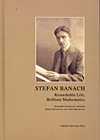- About MAA
- Membership
- MAA Publications
- Periodicals
- Blogs
- MAA Book Series
- MAA Press (an imprint of the AMS)
- MAA Notes
- MAA Reviews
- Mathematical Communication
- Information for Libraries
- Author Resources
- Advertise with MAA
- Meetings
- Competitions
- Programs
- Communities
- MAA Sections
- SIGMAA
- MAA Connect
- Students
- MAA Awards
- Awards Booklets
- Writing Awards
- Teaching Awards
- Service Awards
- Research Awards
- Lecture Awards
- Putnam Competition Individual and Team Winners
- D. E. Shaw Group AMC 8 Awards & Certificates
- Maryam Mirzakhani AMC 10 A Awards & Certificates
- Two Sigma AMC 10 B Awards & Certificates
- Jane Street AMC 12 A Awards & Certificates
- Akamai AMC 12 B Awards & Certificates
- High School Teachers
- News
You are here
Stefan Banach: Remarkable Life, Brilliant Mathematics

Publisher:
Gdańsk University Press/American Mathematical Society
Publication Date:
2012
Number of Pages:
185
Format:
Hardcover
Price:
55.00
ISBN:
9788373264519
Category:
General
[Reviewed by , on ]
Charles Ashbacher
03/8/2012
Despite his unfortunate death in 1945 at the relatively young age of 53, the influence of Polish mathematician Stefan Banach remains significant. His mathematical achievements were enormous, from the Banach-Tarski Theorem that it is possible to split a ball into two pieces, each of which is the same size as the original — one of the most counter-intuitive results of mathematics — to founding work on functional analysis.
However, this book rarely touches on Banach’s mathematical achievements, concentrating on the other aspects of his life. He was born out of wedlock and raised by women other than his mother, although he had a steady relationship with his father. In many ways the most amazing aspect of his life was the fact that he managed to live through World War II.
Being an intellectual in Poland was dangerous in the years from 1939 through 1945, when the Soviet Union and Germany alternated in occupying various sections of the country. Both sides selected large groups of the Polish leadership class for execution and professors were considered part of that class. One of the most amazing events that I have ever read about was how professors were selected to be part of a project controlled by the Germans that made vaccine for typhus. Their role was to feed the lice that were eventually used to cultivate the vaccine. The idea of a group of extremely intelligent men sitting around discussing math/science while their blood was being sucked out by insects is simultaneously amusing and disturbing. Yet, for some, doing this is what allowed them to survive the war.
A collection of recollections and other documents about the life of Stefan Banach, this book is not a biography. It is a set of vignettes that includes reproductions of letters and documents in the life of Banach as well as images. It is a non-intense and nonlinear yet enjoyable book about a brilliant mathematician that lived in unusual circumstances.
Charles Ashbacher splits his time between consulting with industry in projects involving math and computers, teaching college classes and co-editing The Journal of Recreational Mathematics. In his spare time, he reads about these things and helps his daughter in her lawn care business.
- A remarkable life (by Emilia Jakimowicz)
- Letters
- Recollections
- Stefan Banach in the light of archives (by Stanisław Domoradzki, Zofia Pawlikowska-Brożek, and Mikhailo Zarichny)
- Banach's opus scientificus (by Julian Musielak)
- Stefan Banach and Lvov Mathematical School (by Krzysztof Ciesielski and Zdzislaw Pogoda)
- The Scottish Book (by Marek Kordos)
- The New Scottish Book (by Roman Duda)
- Selected bibliography in English and French
- Selected bibliography in Polish
- Biographical notes
- List of illustrations
- Index of names
- Log in to post comments




